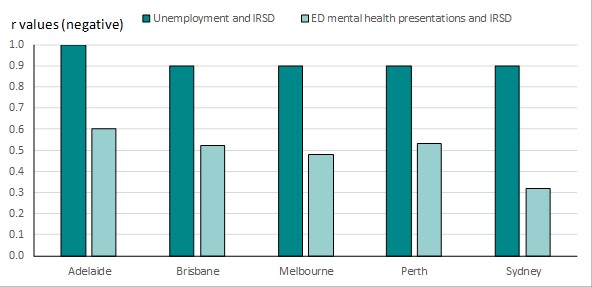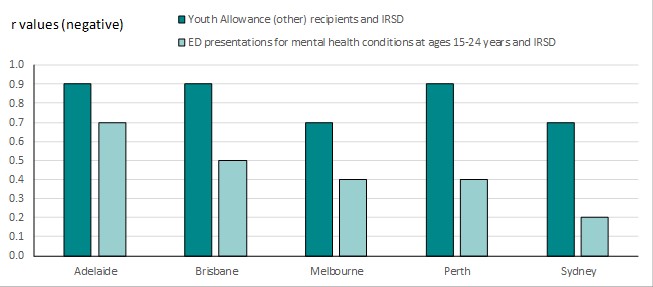COVID-19 impact on unemployment benefits (October 2020): supplemented with Emergency Department (ED) presentations for mental health-related conditions (February 2021)
Unemployment benefits comparison between 2019 and 2020 and ED data, 2017/18
Published: 2020 and 2021
Introduction
One of the greatest impacts of the coronavirus (COVID-19) in Australia has been on jobs – in fact, the loss of jobs, as businesses have scaled down or closed. A major indicator of the impact of loss of jobs is the increase in the number of people receiving an unemployment benefit. In June 2019 there were just over three quarters of a million people receiving an unemployment benefit; by June 2020 this figure had more than doubled, to over one and a half million (the numbers are 769,555 and 1,614,412, respectively).
The associations at the suburb level between unemployment payments and socioeconomic disadvantage in capital cities are very strong, as shown in the chart below. However, correlations between ED presentations for mental health-related conditions and socioeconomic disadvantage are weaker, ranging from moderate to strong, indicating the more widespread nature of these conditions in the population. There are similar associations for the 16-21 and 22-64 year age groups.

In this report we provide maps, graphs and data that show the changes in unemployment payments in the capital cities and regional areas, based on data from the Department of Social Services (DSS 2020), as well as for presentations to EDs for mental health-related conditions.
People receiving the JobKeeper Payment, are not included as the data were not available by small geographical area.
Reference
DSS 2020 at https://data.gov.au/data/dataset/dss-payment-demographic-data
Unemployment benefits defined
Until recently, the payments for eligible unemployed people were the Newstart Allowance and Youth Allowance (other)[1]. From 20 March 2020, JobSeeker Payment replaced Newstart Allowance. Together, these payment types are referred to as ‘unemployment benefits’.
[1] A means tested payment for young people 16-21 years of age, who are looking for full time work or undertaking approved activities.
View Notes on the data
Authored by PHIDU


